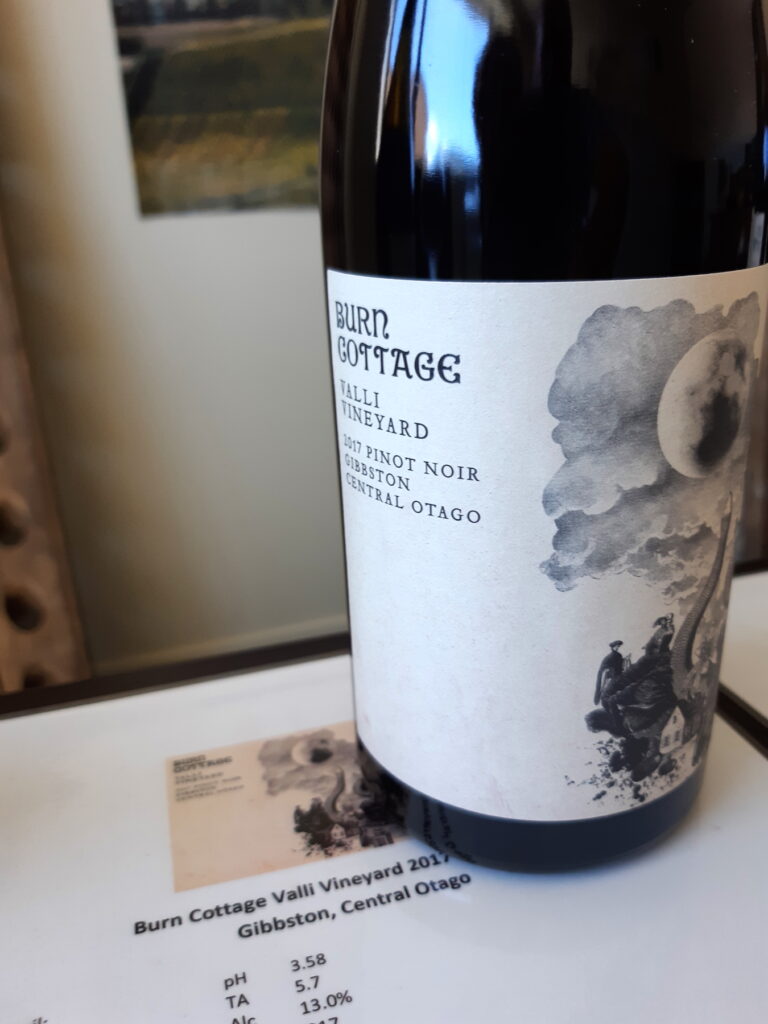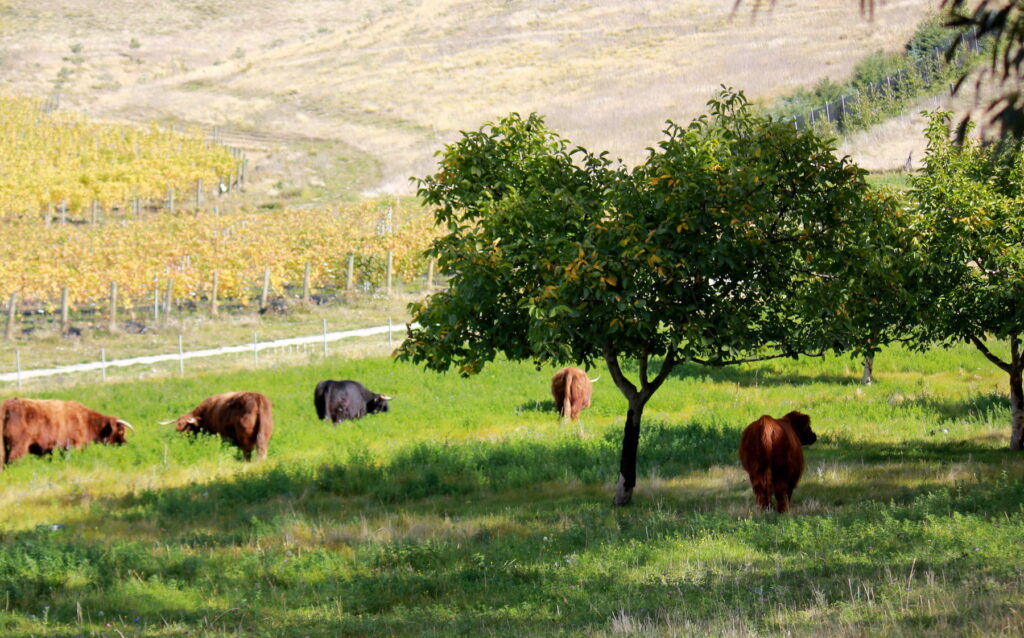Burn Cottage winemaker Claire Mulholland is a well respected figure in New Zealand, and a bit of Pinot Noir legend, having worked at both Martinborough Vineyards and at Amisfield as Head winemaker. Catching up before the 2020 harvest, and the whole Covid-19 situation, we talked about how things are progressing at Burn Cottage and tried a few of their wines.
WineFolio: Burn Cottage is not the best known label around – it doesn’t have the profile of Akarua or Mt Difficulty? I know it’s great wine, but I’m not even sure how I know that – how do you get your message across?
Claire Mulholland: A lot of it is telling our story wherever we can, visitors to our region, and having great restaurant and retail partners in market. We are also fortunate to have great distributors in New Zealand and in our export markets. With our volumes being small we really value those partnerships. We take part in Pinot Palooza events in some markets. People here in New Zealand often still say they’ve never seen our label before, so it just takes time.
Many people who know our wines would be aware that we were established completely with biodynamic and organic means. There was no herbicide, no artificial fertilizers – everything was manure and compost and planting crops to build the soils up, and we planted into that. The team were just out there doing it and didn’t go through any certification processes initially, however more recently we have Biogro certification for our home vineyard in Lowburn from 2017 and are in process to have certification for our Bannockburn Sauvage vineyard from the end of 2020.
We aim to have a Cellar Door at the vineyard at some stage as well, but for now host tastings at our winery in Cromwell.
WF: Do you see the process as more scientific or artistic?
CM: I think both, and that’s what attracts so many different people to the industry. When you meet winemakers there’s a lot of different backgrounds, and especially here in Central Otago there’s quite a gathering of different characters. I feel personally like there’s more towards the art in some ways, but there’s also definitely a bit of both.
WF: And is there a time during the year where you just get a ‘feeling’?
CM: Probably the combination of everything along the way. Right from winter during pruning and then throughout the growing season you see different things – observing the vineyard. Burn Cottage has ten different clones and ten different blocks, various root stock selections, and varied aspects and elevations to the blocks themselves. Each portion of the harvest that comes in, we are looking at it separately before it goes into a fermenter. So getting a feeling for each part of the land as well.

Aiming to bring out the uniqueness of the place, to trust the site, and all the work that’s been done out there during the season. We also have the new ‘Sauvage’ vineyard – in 2017 we started working with that site, but the vines themselves are now 21 years old. That had been managed organically in the past at times, now the team have converted it fully back to those methods.
WF: Is picking your decision?
CM: Yes, but with the vineyard team we have been watching the fruit, the canopy and the weather- as well as how things have been going throughout the season for each block.
Pretty much every block is on either a different soil type, or elevation, or aspect to the sun…So we’ve got different maturity progression there. We try to have a fermenter of each block separately , whether that is in stainless steel or the oak cuves.
WF: do you see anything changing with Climate Change?
CM: We have occasionally had some pretty hot years. We’re less affected in our home site because it’s tucked up under the hill and the suns heat leaves the site a little earlier than some others. But it’s the variability in the climate, or in the seasons which is more of an issue; we have to adjust as best we can.
WF – You’re doing the collaborative project with Valli, and it’s amazing how much of a community the wine industry is. I would have thought there’s no way someone would swap something precious like grapes, to let someone else have a go! Any plans to make a new thing – a grand product?

CM: Yes the collaboration with Valli is a wonderful experience – with people we enjoy spending time with; and the fruit from their special site. Grant and I worked together for several years in the past so its great to be doing that again – we have done 6 vintages for the collaboration so far. . We pick Burn Cottage grapes for him, and he picks Valli grapes for us, from rows and clones we’ve each set aside. We literally do a swap, and end up with three barrels each.
In terms of a future plans at Burn Cottage Vineyard, we have a couple of blocks that we have watched extra closely over the years. As we do those separate ferments for each block we can see the wine throughout as well… It’s possible that one of those small areas will have a special bottling.
Wines appear.
WF: Do you just have the one white?
CM: We planted in a small side valley at the top of our site that has quite mineral and slightly lean soil – we decided it would be interesting for Riesling. Gruner Veltliner was also coming into the region at that time, so those two make up that block. They’ve taken a long time to produce – around 6 years, and it’s still very small volumes so for now we blend the varietals, and they work very well together. The blend is usually 30-50% Gruner Veltliner and the remainder Riesling. We usually do skin contact on both most years – some years just one of them – bringing out the lovely texture from the skins.
The Gruner has brings the acidity of the wine back a little from where a Riesling would sit. Usually dry or just off-dry.. the natural ferments will often just stop where they stop.
WF: Whose choice was that, to put those grape varieties in? And why not Chardonnay?
CM: The owner of Burn Cottage – Marcus Sauvage, and Ted Lemon – who established the vineyard, the planting layout, and clonal/rootstock makeup, and put in place the biodynamic groundwork and farm integration (as he has done in his own site, Littorai, in Somoma Coast) I started with the team at Burn Cottage in 2010. We talked about Chardonnay a few times, and especially as Ted makes beautiful Chardonnay at his Estate, however Pinot Noir has been very suited to this site, and has been the main focus.

CM: Moonlight Race is a sub-regional reflection of Pinot Noir from around our area. Up to 2017 vintage the wine is a blend of fruit from Burn Cottage and two other vineyards in the region where we had rows set aside year on year. These Vineyards were Northburn and Mark 2 (Pisa area). We worked very closely with them on this. From 2018 onwards this wine becomes just our two vineyards, in Lowburn and Bannockburn.
The 2016 is very textural, silky. The season was fairly mild, but even, apart from wind which was a bit of a challenge. Very different wines (V16 / V17) to look at but you can see similarities from the mineral, savoury, textural elements. Burn Cottage site has very earthy, mineral notes.
2017 was very low production. We had a relatively unsettled weather at flowering, so there was poorer fruit set. The fruit ripened really well, giving a lovely density and structure to the wines. The Burn Cottage site savoury depth is there – the fruit and oak complement each other – only a low percentage of new oak used. The Mark 2 vineyard always lend savoury herb and spice notes, and Northburn dark red fruits and structural tannins. All three vineyards are within 10 kilometres of each other giving a lovely regional representation.





One Comment on “Winemakers series: Claire Mulholland”